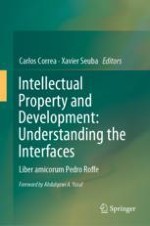2019 | OriginalPaper | Chapter
Traditional Knowledge and the Public Domain in Intellectual Property
Author : Ruth L. Okediji
Published in: Intellectual Property and Development: Understanding the Interfaces
Publisher: Springer Singapore
Activate our intelligent search to find suitable subject content or patents.
Select sections of text to find matching patents with Artificial Intelligence. powered by
Select sections of text to find additional relevant content using AI-assisted search. powered by
